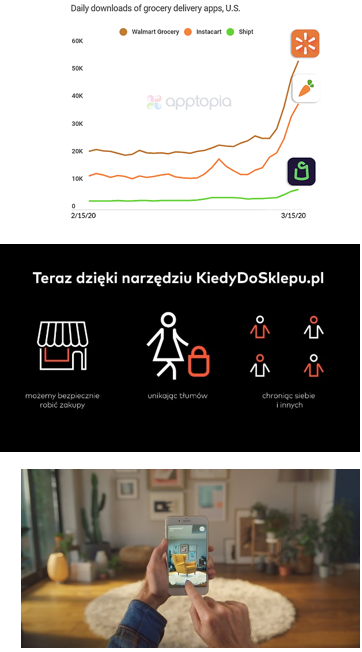The term “Zero Touch Retail” has recently become widespread, which is an idea that has a huge impact not only on how stores operate, but also well defines the change in consumer behaviour. It is worth looking at some of the areas where the biggest changes in the context of contactless commerce have taken place:

#1 – E-commerce is becoming more dynamic, especially in terms of “everyday shopping”. The graph next to it shows a rapid increase in the dynamics of shopping application downloads during the pandemic. Since people who start using e-commerce tend to continue this habit, we can assume that this is not just a lockdown phenomenon and will continue afterwards.
#2 – Avoid rush hours and control the number of people shopping. Logically, the fewer people in the store, the lower the risk of illness – consumers checked the traffic in individual stores (helped by a MasterCard application). Another interesting phenomenon was managing relations with customers who are waiting in line to enter the stores. In some cases, retailers were connected to those waiting and could start advising them before entering the store, which reduced the feeling of lost time. It was also interesting to start booking the exact time of visits to selected retailers.
#3 – Communication around hygiene issues In addition to the gloves and disinfectant gels on display, the stores actively educated and supported customers in the context of hygiene principles.
Examples of activities included:
- QR codes on POSM, which led to instructions on how to avoid infection in the store or show how the cleaning process for store surfaces was carried out and when it was done. Such QR codes were also placed on the purchase bills Location-based messages in the application – in case we wanted to try on e.g. shoes from a given showcase or a dress, we could check exactly when the given location was disinfected.
#4 – Alternate Reality as a touchless shopping support. AR-based applications such as the IKEA Place App are gaining in importance so that customers can spend less time in the store and come better prepared. The pressure of contactless shopping automatically shifts the burden to the virtual experience of the product before shopping, especially in engaging categories.Other areas that have changed within the Zero Touch Retail concept are the way of paying (touchless and mobile) and delivery. If we are a “retailer” brand, it is worth looking at our actions from the perspective of the comprehensive Zero Touch Retail program, which is an opportunity for many innovative solutions.
Source: https://blog.beaconstac.com/2020/05/contactless-retail-covid-19/

